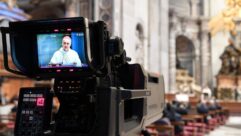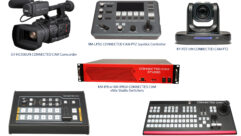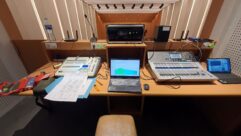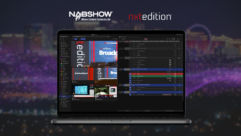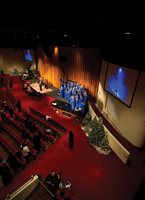

Worship Workflow
Jan 7, 2011 12:00 PM,
By Mark Johnson
A week in the life of a church technical volunteer.
The 1400-seat auditorium in the new, larger
sanctuary at Hilltop Community Church in
Richmond, Calif., depends on volunteers to run its audio, lighting, video, media, and IT.
I’m a church volunteer and an AV professional. I’m an exception.
Today, churches large and small are equipped with concert-quality sound systems, broadcast-quality video equipment, and theatrically based lighting systems. Outside of church, people live in a world where laptop manufacturers tout that their computers are fitted with studio-quality audio. People watch HD television and see 3D movies. It’s what they’ve come to expect, and they expect it when they go to church as well. The challenge is that while professional AV technology can be and is being integrated into worship systems, technology does not operate itself. And the majority of the people who serve their churches have day jobs that connect to AV only by the farthest stretch of the imagination.
Every week, grocery clerks, insurance salespeople, and factory workers across the country transform into video directors, live sound mixers, and lighting designers. These volunteers influence technology decisions in direct and indirect ways. If the volunteers have limited experience and skill, a church must factor that into the design and mission of its AV systems. If volunteers are knowledgeable, they may assert preferences regarding equipment and features. And if volunteers can increase their skills, then the AV system can be more complex and help to provide a more contemporary worship experience.
The words “ease of use” or “usability” are often tossed around. But it may be difficult for an AV pro to define “ease” because he cannot always see things from the viewpoint of a volunteer. With that in mind, let’s take a close-up look at one real-world example: my church.
Hilltop Community Church has been serving the Northern Californian community of Richmond since the 1920s, using living rooms, tents, storefronts, converted shopping centers, and purpose-designed and -built facilities to hold services. Volunteerism has always played a large part in the life of Hilltop. And in fact, all of the technology departments at Hilltop are currently volunteer-based and -run. This includes audio, lighting, video, media, and even IT. I’m one of eight people on the audio team.
In 2003, a project to build a new, larger sanctuary was undertaken with the idea of creating a venue that could be made available to the community as well house our growing congregation. The facility would have a 1400-seat auditorium, classroom/meeting spaces, and offices for church staff. The new structure was to be built immediately adjacent to and connected to the existing facility.
We’ve been in the new facility for two years now. And after our having occupied the other facility since the 1970s, the move, while welcome and greatly anticipated, was and still is not without challenges. To save money, whatever equipment that could be brought over from the old sanctuary and was reinstalled in the new facility. That included Shure ULX wireless mic systems, CanonXL1S and XL2 videocameras, and desktop computers running EasyWorship church presentation software, and an assortment of lighting instruments. New purchases included a YamahaPM5D mixing console, a Meyer SoundM’Elodie line-array loudspeaker system, and a Clear-Com intercom system. An ETCSmartFade ML lighting console and Source Four PARs were also purchased and installed to provide a basic lighting system for the new worship center. Subsequent purchases included some Chroma-QColor Force LED cyc lights, and some JBLSRX700 series speakers to be used for monitors. The two side projectors are Sanyo PLC-XT35L 5000-lumen projectors. The center projector is a Sanyo 12,000-lumen PLC-XF46N.
The technology teams worked closely with Bill Platt of Platt Design Group for the design, integration, and implementation of the new and existing equipment.
Worship Workflow
Jan 7, 2011 12:00 PM,
By Mark Johnson
A week in the life of a church technical volunteer.

The new worship center has already hosted several events and concerts such as the Unashamed Tour.
Best Practices
Historically, smaller churches run very much by the seat of their pants or on a wing and a prayer. As a church grows, logistics and planning become more important. Generally, there are more people involved in the production of the service, and the production of the service is more complicated technically. Because getting a large volunteer production team (plus singers and musicians) together during the week for rehearsals or production meetings can be problematic, good advance planning and communication are key elements in having successful volunteer technical ministries and smooth-running services.

Volunteers control video switching for IMAG and recording.
We try to establish routines and procedures that are scalable that we can all do on a consistent basis and incorporate them through all venues on the church campus. Those venues include our main sanctuary, the old sanctuary (renamed the Family Ministries Chapel, where we also hold services and our youth meets), and our Fellowship Hall (where the kids ministries meet).
Specific documentation that we developed for our use includes an Order of Service form, which breaks down the service into sections and lets us know what will be happening on the platform and who is involved at any given time in the course of the service. Another piece of helpful documentation is our Mic Matrix. It is a listing of our wireless microphones and who will be using a particular mic during the sections of the service. The Order of Service, the Mic Matrix, and the cues on the PM5D all reflect the same steps that happen as the service progresses, so there is continuity in how we address the proceedings of the service.
Churches often have rotating groups of singers, or at least a variety of singers who will participate in a service on a week-to-week basis. I find in many churches, for example, singers grab whatever mic is nearest to their hands and start singing, often changing from one mic to another over the course of the service. Our mics are numbered and set out in order (1 through 6 are designated for the praise and worship team, mic 7 is for the soloist who will sing with the choir, and mic 8 is for whoever will be singing special music) and the same location each week. This info is noted on the Mic Matrix. The singers are responsible for remembering what mic number they used during rehearsal and then using that same mic for the actual service. The exception to this process is if someone is pulling double or triple duty and singing at other times during the course of the service (for example, singing on the praise and worship team and as a choir soloist). That person then uses the same mic throughout. We’re able to cut and paste the singer’s mic settings from the initial cue into subsequent cues and make minor adjustments for the particular song.
Our basic goals during the service are to support the church leadership in presenting the message and not be a distraction. Distractions during a service can manifest themselves in various ways including bad or too loud (or too soft) audio, shaky video, and too active lighting.
Since there are so many amateurs involved in the production of the service, another key is to reduce the margin for error. This could by simply an operation or process, or a limit on the number of times a microphone gets handled to just one or two people.
Worship Workflow
Jan 7, 2011 12:00 PM,
By Mark Johnson
A week in the life of a church technical volunteer.

For IMAG, Canon XL1S and XL2 videocameras—one in the balcony and two on the main floor—capture the action, which is displayed on three projection screens in the main sanctuary.
The Week at a Glance
Wednesday is rehearsal for the praise and worship band and singers. Prior the start of the rehearsal, the music director posts an Order of Service form he’s filled out. This form includes a list of who the singers will be for the upcoming weekend, as well as the band configuration and the musicians. There are also notes for video and for the Easy Worship operators. We’ll fill in specific information such as running times of CDs or DVDs, source inputs, etc. We’ll also fill in the Mic Matrix so we can plan and coordinate the usage of the wireless systems in the course of the service.
The digital mixing console is a great tool for houses of worship. We have basic scene or event cues derived from a master cue that we named “Old School,” which is basically set up as if we were mixing on an analog console. Subsequent cues for running the service include Pre Service, Praise & Worship, Choir, Special Music, Message, and Post Service. Primarily, the cues serve to turn on or off various inputs for that particular time in the service, though level or EQ changes are programmed in as well if needed.
Since we have a basic setting for the band and the set of musicians are pretty consistent from week to week, most of our attention is focused on the singers, setting the input gains, and adjusting the EQ. There are typically five or six singers, basically covering bass/tenor, alto, and soprano vocal parts. The makeup for the band is drums (electronic), bass, electric guitar, keys, percussion, flute, and piano. Occasionally another guitar (acoustic or electric) is added to the mix.
Youth services (teens) also take place on Wednesday evenings in the Family Ministries Chapel. We try to have the youth run the technical aspects of their services. It helps to give them ownership and provides a training platform so they can continue to serve as they get older. There is a MackieTT24 digital mixer in the chapel. Since we run three different services in the course of the week in that facility, having a digital mixer is helpful as we can set different cues for the services.
Thursday is choir rehearsal. For audio, our time is minimal. The choir rehearses in another room entirely and then comes out to the main sanctuary to run through the song it will sing that weekend. If the song is sung to prerecorded tracks, that allows us the opportunity to set levels and EQ on the tracks and check the overall mix with the choir and any soloists that might be involved in that particular song. If the band is playing for the choir song, we save the band settings from the praise and worship cue into the choir cue, possibly cutting the levels on some of the louder instruments so the band won’t overpower the choir. Since that takes between 15 to 30 minutes tops, the remainder of our time in the evening is spent doing maintenance or other preparations or projects.
On Sunday, we hold morning services in two locations: early morning at 8:30 a.m. in our chapel and 10:30 a.m. in the new sanctuary. The early service is a streamlined version of the main service that features members of the youth band, three singers, and no choir. (We’ve been in the new sanctuary for two years now, but we still call it “new.” We’re still in what I call a “period of discovery” with the systems there as we continue to refine our processes and procedures as well as integrate products or systems that were value-engineered out of the original system design.)
There is also another service on Sunday evening at 6 p.m. in the chapel. We have a rotating schedule for the members of the sound team. Normally, one person will mix the services in the chapel and another person will mix the service in the new sanctuary. We also record the 10:30 a.m. service for duplication on DVD and distribution, and we send stems to the audio suite and provide a separate record mix for the DVD. Senior Pastor Jim Heden delivers the message for all three services, referring to his notes on an AppleiPad . He normally downloads the notes from his desktop, but if needed, he can connect wirelessly to his desktop via the LogMeIn app.
There are three projection screens in the main sanctuary: one in the center and one on each side. We’ll do IMAG on the center screen, and the side screens typically display sermon notes. We use video switches for IMAG primarily. There are three cameras, one in the balcony and two on the main floor. Sometimes additional cameras will be used for special occasions or events.
Worship Workflow
Jan 7, 2011 12:00 PM,
By Mark Johnson
A week in the life of a church technical volunteer.

A Yamaha PM5D mixing console in the main sanctuary provides control over equipment including Shure ULX wireless mic systems. Sound is piped through a Meyer Sound M’elodie line-array system, and JBL SRX700 series speakers are used as monitors.
Depending on our individual work schedules or if there are any special events or presentations, we may come in on other days. Concerts and events that have been held in the new facility include Christian artists Tommy Walker and Paul Baloche. And while the sound system was designed to support a concert type of event, we had never put the pedal to the metal to see what she’ll do. The opportunity arose when the Unashamed Tour—a Christian hip-hop and rap tour featuring Lecrae, Trip Lee, Sho Baraka, Tedashii, DJ Official, and Pro—selected Hilltop as its Northern California stop. I’m happy to report the system had more than enough level and punch to satisfy a standing-room-only crowd of teenagers for 3 hours of high-energy rap and hip-hop. We did supplement the low end with some additional subwoofers. We have hosted community meetings, and Hilltop was a training site for census workers. We also were a satellite site for Willow Creek Association’s annual Leadership Conference this past August.
While we are functioning, there is still work to be done, including completing the lighting and video systems, as well as resolving some issues with the building proper. Getting the old sanctuary back up and running was a challenge for the all-volunteer crew. Part of the original concept for the new facility included a café/coffeehouse, but that part of the construction was initially stalled due to budget constraints. The completion of that part of the building is now a focus. The end of the year is also very busy as we juggle regular services as well as preparations for our annual Christmas production.
Being a volunteer at a house of worship can be immensely satisfying and also extremely frustrating at the same time. Things can go undone because there is not necessarily an advocate on the full-time staff for your particular cause or concern, and communication is always a challenge. However, an especially meaningful and impactful service or a successful event can be great reminders of why we do this.


